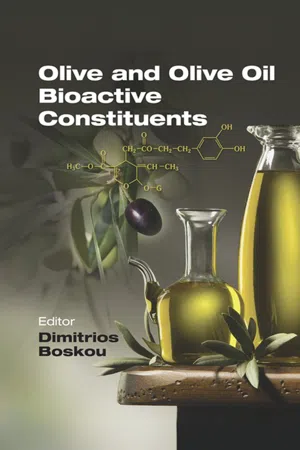
- 422 pages
- English
- ePUB (mobile friendly)
- Available on iOS & Android
Olive and Olive Oil Bioactive Constituents
About This Book
The market is flooded with products posing as elixirs, supplements, functional foods, and olive oil alternatives containing phenols obtained from multiple olive sources. This technically-oriented book will be of value to nutritionists and researchers in the biosciences. It unravels the body of science pertaining to olive minor constituents in relation to new chemical knowledge, technological innovations, and novel methods of recovery, parallel to toxicology, pharmacology, efficacy, doses, claims, and regulation.
Topics include: the biological importance of bioactive compounds present in olive products; developments and innovations to preserve the level of bioactives in table olives and olive oil; and importance of variety, maturity, processing of olives, storage, debittering of olives and table olives as a valuable source of bioactive compounds.
- Presents detailed information concerning the claimed benefits of olive oil and discusses the permitted health claim to EFSA on oils with natural phenolics
- Recovery of bioactive constituents from olive waste is comprehensively described
- Explores the relationship betwen phenolic levels and sensory evaluation
- Features chapters on the clinical and cellular mechanisms and health effects of olive, important for functional foods research
Frequently asked questions
Information
Olive Fruit, Table Olives, and Olive Oil Bioactive Constituents
Introduction







Olive and Olive Oil Bioactive Ingredients
The Terms Polyphenols and Unsaponifiables
Unsaponifiables
Phenolic Compounds Identified in Olives and Olive Oil
Table of contents
- Cover image
- Title page
- Table of Contents
- Copyright
- Preface
- About the Editor
- Contributors
- List of Abbreviations
- Chapter 1: Olive Fruit, Table Olives, and Olive Oil Bioactive Constituents
- Chapter 2: Minor Bioactive Olive Oil Components and Health: Key Data for Their Role in Providing Health Benefits in Humans
- Chapter 3: Cellular and Molecular Effects of Bioactive Phenolic Compounds in Olives and Olive Oil
- Chapter 4: Olive Oil Phenolic Composition as Affected by Geographic Origin, Olive Cultivar, and Cultivation Systems
- Chapter 5: Effect of Fruit Maturity on Olive Oil Phenolic Composition and Antioxidant Capacity
- Chapter 6: From Drupes to Olive Oil: An Exploration of Olive Key Metabolites
- Chapter 7: Research and Innovative Approaches to Obtain Virgin Olive Oils with a Higher Level of Bioactive Constituents
- Chapter 8: Table Olives as Sources of Bioactive Compounds
- Chapter 9: Bioactive Phenolic Compounds from Olea europaea: A Challenge for Analytical Chemistry
- Chapter 10: Analysis of Bioactive Microconstituents in Olives, Olive Oil and Olive Leaves by NMR Spectroscopy: An Overview of the Last Decade
- Chapter 11: Recovery of High Added Value Compounds from Olive Tree Products and Olive Processing Byproducts
- Index